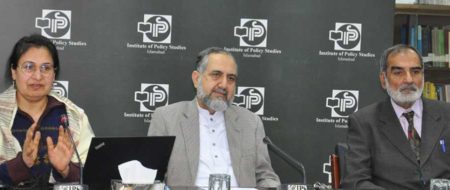2030 solar and wind roadmap for Pakistan
Renewable energy officials, experts discuss ways to de-carbonize power sector
Renewable energy officials and experts in an international webinar titled ‘2030 solar and wind roadmap for Pakistan: Accelerating the development of wind and solar power beyond current governmental plans’, organized jointly by Agora Energiewende, Germany and Institute of Policy Studies (IPS) on March 1, 2023 reviewed and discussed the ‘2030 solar and wind roadmap for Pakistan’ chalked out by National Power Regulatory Authority (NEPRA) under its Indicative Generation Capacity Expansion Plan (IGCEP) 2022-31.
The speakers included Shah Jahan Mirza, CEO, Alternative Energy Development Board (AEDB), Ali Zain Banatwala, deputy managing director, National Transmission & Despatch Company (NTDC), Tobias März, German climate activist and solar engineer associated with ‘8.2 Renewable Energy Experts’, Hassan Jafar Zaidi, CEO, Power Planners International (PPI), Naila Saleh, project manager, Agora Energiewende, and Lubna Riaz, researcher, Energy, Water & Climate Change Program, IPS.
Shah Jahan Mirza reiterated the government’s commitment towards lessening reliance on fossil fuels and de-carbonization of the power sector by ambitious targets of renewable energy uptake as outlined in the Alternative and Renewable Policy 2019, which aims to boost the renewable energy share to 30 per cent by 2030.
The government is motivated to make the necessary transit to renewable energy sources on a war-footing basis. Also, many mega-scale and distributed generation projects based on solar PV are in the pipeline and AEDB was committed to their timely execution, he said.
Sharing the government’s vision to uptake the renewable energy share, Banatwala highlighted that the renewable energy integration with the grid may cause some issues with the system operations of the grid due to the intermittent nature. However, he said, NTDC is playing its role by carrying out a detailed analysis of the scenarios of renewable energy uptake mandating the collective efforts of de-carbonization of the power sector at the earliest.
The RE experts discussed the results of an ambitious solar and wind roadmap performed by ‘8.2 Renewable Energy Experts’ and ‘Power Planners International’ offering recommendations for accelerating the development of wind and solar power beyond the governmental target adopted in the IGCEP.
The study titled “Beyond IGCEP 2022” reviews the 10-year generation expansion planning for Pakistan and analyzes if a more ambitious pursuit of solar and wind power (“VRE”) by 2030/31 would be possible and beneficial. Based on the hourly dispatch of the year 2030, it comes to the conclusion that an increase of the planned total VRE capacity from 20 GW to 33 GW by 2030 would be possible by adding minor grid infrastructure reinforcements. Furthermore, this would reduce energy generation total emissions by 50 per cent and the average energy generation costs by 15 per cent. The study recommends including this more ambitious target in the next iteration of the IGCEP (due for June 2023), pursue a strategic reinforcement of the road infrastructure (including the HVDC link to Chaghai in Balochistan), put a strong focus on the flexibilization of the operation of hydro and coal units as well as implementing a stringent and localized annual tender plan for auctioning out the 33 GW of solar and wind power throughout the next ten years.
In this scenario, the rooftop solar system has a huge potential and can be a win-win providing sustainability, security of supply, and affordability, highlighted Saleh. For Pakistan, rooftop solar makes a compelling case as it can help in meeting local demands, reduce capacity payment burden and transmission and distribution losses, and manage daytime peaks.
She emphasized the need to design suitable business models which ensure a viable business case for involved stakeholders and address the prevalent challenges in the socio-technical system, e.g. high upfront cost, finance mobilization problems, regulatory gaps, and lack of facilitative organizational, business, and finance models.
With this, it becomes evident that the socioeconomic development of the communities is highly dependent on access to energy. While enhancing grid infrastructure to the off-grid areas, in which about 50 million of the population resides, has remained a strangled issue, mini and micro-grids (MGs) provide a favorable option for electrification, underscored Riaz.
These grids provide a midway between standalone and grid systems as they operate like autonomous and decentralized electricity networks capable of functioning separately from a national grid. This would improve rural livelihood and increase local business growth by adding value creation to local products and services. Moreover, RE-dominated MGs present much more financial feasibility as compared to conventional fossil-fuel-based generation, she added.












